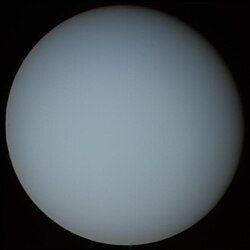Difference between revisions of "Translations:AY Honors/Stars/Planet characteristics/8/es"
(Created page with "===Urano=== thumb|250px|right|Urano Urano es el séptimo planeta desde el Sol. Es un gigante de gas, la tercera más grande de diámetro y cuarto más gra...") |
m (FuzzyBot moved page Translations:Adventist Youth Honors Answer Book/Stars/Planet characteristics/8/es to Translations:AY Honors/Stars/Planet characteristics/8/es without leaving a redirect: Part of translatable page "Adventist Youth Honors Answer Book/Stars/Planet characteristics") |
Latest revision as of 22:23, 8 September 2021
Urano
Urano es el séptimo planeta desde el Sol. Es un gigante de gas, la tercera más grande de diámetro y cuarto más grande en masa. Urano está compuesto principalmente de gas y varios hielos. La atmósfera es de aproximadamente 85% de hidrógeno, 15% de helio y trazas de metano, mientras que el interior es más rica en elementos más pesados, lo más probable compuestos de oxígeno, carbono y nitrógeno, así como materiales rocosos. Esto está en contraste con Júpiter y Saturno, que son en su mayoría hidrógeno y helio. Una de las características más distintivas de Urano es la inclinación axial de noventa y ocho grados. En consecuencia, para una parte de su órbita un polo enfrenta el sol continuamente mientras que el otro polo no. En el otro lado de la órbita de Urano, la orientación de los polos hacia el Sol se invierte. Entre estos dos extremos de su órbita, ¡el Sol normalmente sale y se pone alrededor del ecuador!

